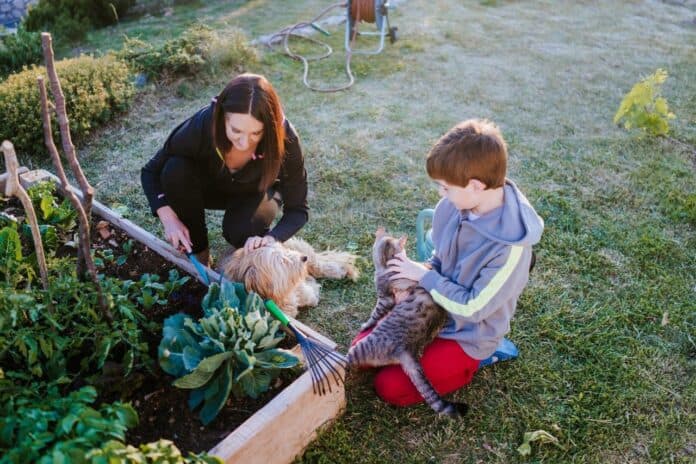Spring has sprung! With warmer weather, more and more people and their pets are spending time outdoors.
Gardening offers the opportunity to enjoy the sunshine and get your hands dirty while you make your yard prettier — or, if you’re growing fruits and veggies, tastier!
You can include your pets in your gardening fun. Here are four quick tips to creating a safe garden that you and your pets can enjoy!
1. Choose Your Plants Wisely
When you’re planning out which plants to put in your garden, keep toxicity in mind.
For example, lilies are beautiful and popular choices for flower gardens, but the majority of lilies are deadly to cats. Lilies in the Lilium and Hemerocallis genuses cause lily poisoning. Within hours, lily poisoning will make a cat very ill, and in less than a day, it can create irreversible kidney damage. Ingesting even a tiny amount of pollen (like licking it off their paw while grooming) can lead to lily poisoning.
While you’re planning out your vegetable garden, check to make sure that your crops are safe for pets. The leaves and stems of tomato plants are toxic to both cats and dogs, as well as garlic, onion, and chives. Eaten in large quantities, broccoli and kale can cause digestion issues in dogs.
“Many pets enjoy eating a variety of plants grown in a garden,” said Virginia Edwards, collegiate assistant professor at the Virginia-Maryland College of Veterinary Medicine. “So you might consider raised beds to keep produce off the ground or fencing around parts that you don’t want to share with your pets.”
2. Store Chemicals Responsibly
Many gardeners use insecticides and fertilizers to enhance their garden — after all, everybody wants to see their garden thrive, and nobody wants to see their plants destroyed by pests. Make sure to store your insecticides and fertilizers in safe containers out of your pets’ reach.
Compost should also be stored away from pets. Dogs in particular tend to be drawn to the pungent smells wafting from the compost pile. However, decaying food leads to mold, which can produce mycotoxins. Dogs who ingest mycotoxins can develop tremorgenic neuromycotoxicosis, which can cause vomiting, tremors, seizures, a rapid heartbeat (tachycardia), and in some cases death.
3. Don’t Create a Haven for Ticks and Mosquitoes
Aphids might chew on your plants, but the ticks and mosquitoes in your garden can spread diseases.
Ticks transmit many diseases to both humans and animals, including Lyme disease. Because ticks thrive in tall grasses, make sure to mow your grass and keep weeds and other debris to a minimum in your garden.
Mosquitoes lay their eggs in standing water, so make sure that your garden is well-drained and that any buckets or birdbaths are emptied regularly. In addition to mosquitoes, standing water is also prime habitat for the bacteria that causes leptospirosis.
Taking precautions against ticks and mosquitoes will make you and your pets safer, happier, and less itchy!
4. Keep It Cool
Hot summer days are coming soon. Keep you and your pets healthy by creating shade spots!
Some gardens and yards have cement or brick walkways or patios. It’s important to note that these surfaces heat up in warm weather and can damage your pet’s paw pads. Make sure that your pets have cooler surfaces, like grass, to walk on when they’re in the garden with you.
For both cats and dogs, excessive panting and drooling are signs that your pet is overheating. Heat stroke is no joke — it’s important to get your pet inside and cooled off if they show signs of heat stroke.
With these tips, we hope that you and your pet can enjoy many beautiful days in the garden together!
By Sarah Bordreau


